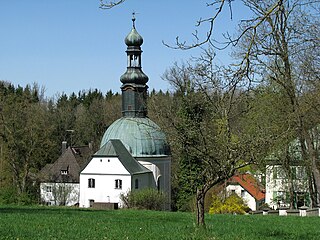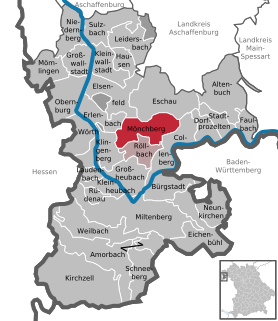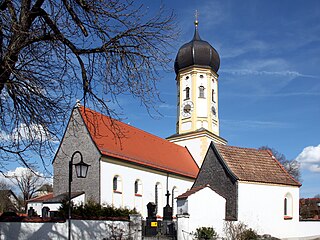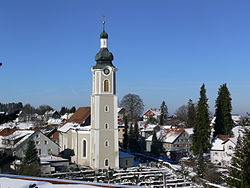
Ruhpolding is a municipality of the Traunstein district in southeastern Bavaria, Germany. It is situated in the south of the Chiemgau region in the Alps and next to the Austrian border.

Bad Wörishofen is a spa town in the district of Unterallgäu in Bavaria, Germany, known for the water-cure (hydrotherapy) developed by Sebastian Kneipp (1821–1897), a Catholic priest who lived there for 42 years. Many of the resort hotels and boarding-houses in Bad Wörishofen offer their guests treatment using Kneipp's methods.

Bischofsgrün is a municipality in the district of Bayreuth in Bavaria in Germany.

Ofterschwang is a municipality in southern Germany, in Oberallgäu, Bavaria. It is a professional winter sports venue, regularly used for World Cup alpine events.

Wasserburg am Bodensee is one of the three Bavarian municipalities on the shores of Lake Constance. It is a well known resort, sought out for the supposedly healthy nature of its atmosphere.

Prien am Chiemsee is a municipality in the Upper Bavarian district of Rosenheim in Germany. The town is a certified air and Kneipp spa on the western shore of the lake of Chiemsee, 16 km (9.3 mi) east of Rosenheim.

Bad Berneck is a spa town in the district of Bayreuth, in Bavaria, Germany. It is situated on the White Main river, in the Fichtelgebirge mountains, 13 km northeast of Bayreuth. Its official title is Bad Berneck im Fichtelgebirge. It lies in the northern part of the Bavarian province of Upper Franconia. Since 1857 it has been a spa, initially based on its climate and whey products. In 1930 it became a Kneipp spa and, in 1950, a Kneipp health spa.

Bad Kötzting is a town in the district of Cham, in Bavaria, Germany, near the Czech border. It is situated in the Bavarian Forest, 15 km (9.3 mi) southeast of Cham.

Wertach is a small town in the Oberallgäu district, southern Bavaria, (Germany), in the German Alps. It is situated on the river Wertach, southeast of Kempten. The town was the childhood home of the writer W. G. Sebald.

Röhrmoos is a municipality in the district of Dachau in Bavaria in Germany. It is located ca. 25 km northwest of München. The community is located between the Amper and Glonn valleys.

Weiler-Simmerberg is a market town in the Swabian Lindau district.

Maierhöfen is a municipality in the district of Lindau in Bavaria in Germany.

Opfenbach is a municipality in the district of Lindau in Bavaria in Germany.

Stiefenhofen is a municipality in the district of Lindau in Bavaria in Germany and the seat of the administrative community of Stiefenhofen.

Mönchberg is a market community in the Miltenberg district in the Regierungsbezirk of Lower Franconia (Unterfranken) in Bavaria, Germany. It is the seat of the Verwaltungsgemeinschaft of Mönchberg and a state-recognized climatic spa (Luftkurort).

Aying is a municipality in the district of Munich in Bavaria, Germany. It is known for the Ayinger Brewery.

Bad Feilnbach is a municipality in the Upper Bavarian district of Rosenheim at the foot of Wendelstein Mountain in Germany. As a famous 'Moorheilbad' the municipality was awarded in 1973 the title "Bad". Since the 19th century the peat deposits were the basis for a continued expansion of the spa and health facilities. The recognized healing success of "black gold" on a variety of diseases were the basis for the development of a well-known spa and tourist community. Due to its wooded surroundings and the mild climate Feilnbach is called the "Bavarian Meran". The entire municipality is recognized as a healing spa resort except for parts of the former municipality Dettendorf.

Bad Grönenbach is a market town in the district of Unterallgäu in Bavaria, Germany. It belongs to the region of Upper Swabia and the headquarters of the Gemeindeverband of the same name.

Marktoffingen is a municipality in the district of Donau-Ries in Bavaria in Germany.

Kirchhaslach is a municipality in the district of Unterallgäu in Bavaria, Germany. The town has a municipal association with Babenhausen, Bavaria.



























